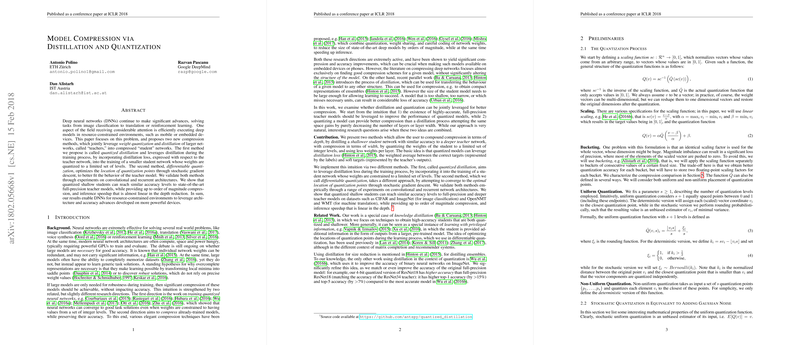Model Compression via Distillation and Quantization
In the paper "Model Compression via Distillation and Quantization," the authors address a critical issue in deploying deep neural networks (DNNs) in resource-constrained environments such as mobile devices. The paper introduces two innovative methods for model compression: quantized distillation and differentiable quantization. These techniques aim to effectively reduce model size and computation while maintaining competitive accuracy levels.
Overview of Contributions
The authors develop methods that jointly leverage knowledge distillation and weight quantization. Distillation involves transferring the learned knowledge from a larger "teacher" model to a smaller "student" model. Quantization, on the other hand, reduces model size by constraining weights to a limited set of values.
- Quantized Distillation: This method incorporates distillation loss during the training of quantized students, integrating both quantization and distillation processes. It allows the student model to closely mimic the performance of the teacher model despite having significantly reduced complexity.
- Differentiable Quantization: This method focuses on optimizing quantization points via stochastic gradient descent. By adjusting the location of these points, the method better aligns the quantized model's behavior with that of the teacher model.
Empirical Validation and Results
The methods are validated across various architectures, including convolutional and recurrent models. Experimental results demonstrate that quantized students achieve accuracy levels comparable to full-precision models with substantial compression — sometimes up to an order of magnitude in size reduction. Notably, in vision tasks such as CIFAR-10 and CIFAR-100, quantized models retained nearly the same accuracy as their full-precision counterparts, demonstrating the effectiveness of the proposed techniques.
Critical Insights and Implications
- Automatic Inference Speedup: By reducing model depth, the methods automatically enhance inference speed, making DNNs more feasible for real-time applications on embedded systems.
- Generalization to Large Datasets: The approaches maintain accuracy even when scaling to larger datasets, as seen in experiments with ImageNet and WMT13.
- Quantization as Noise Addition: The paper provides a theoretical analysis showing that quantization acts as adding Gaussian noise to the model weights, which can be interpreted as a form of regularization.
Future Directions
The research opens several paths for future exploration:
- Automated Architecture Search: Employing reinforcement learning to explore optimal student network architectures could provide further efficiency improvements.
- Integration with Hardware Optimizations: Testing these compression methods on specialized hardware, such as FPGAs or using frameworks like NVIDIA TensorRT, could yield further performance benefits.
In conclusion, this paper contributes valuable insights and methods for compressing DNNs, enabling the execution of complex models in constrained environments without sacrificing performance. These advances could significantly impact real-world applications by making AI more accessible and efficient on edge devices.
